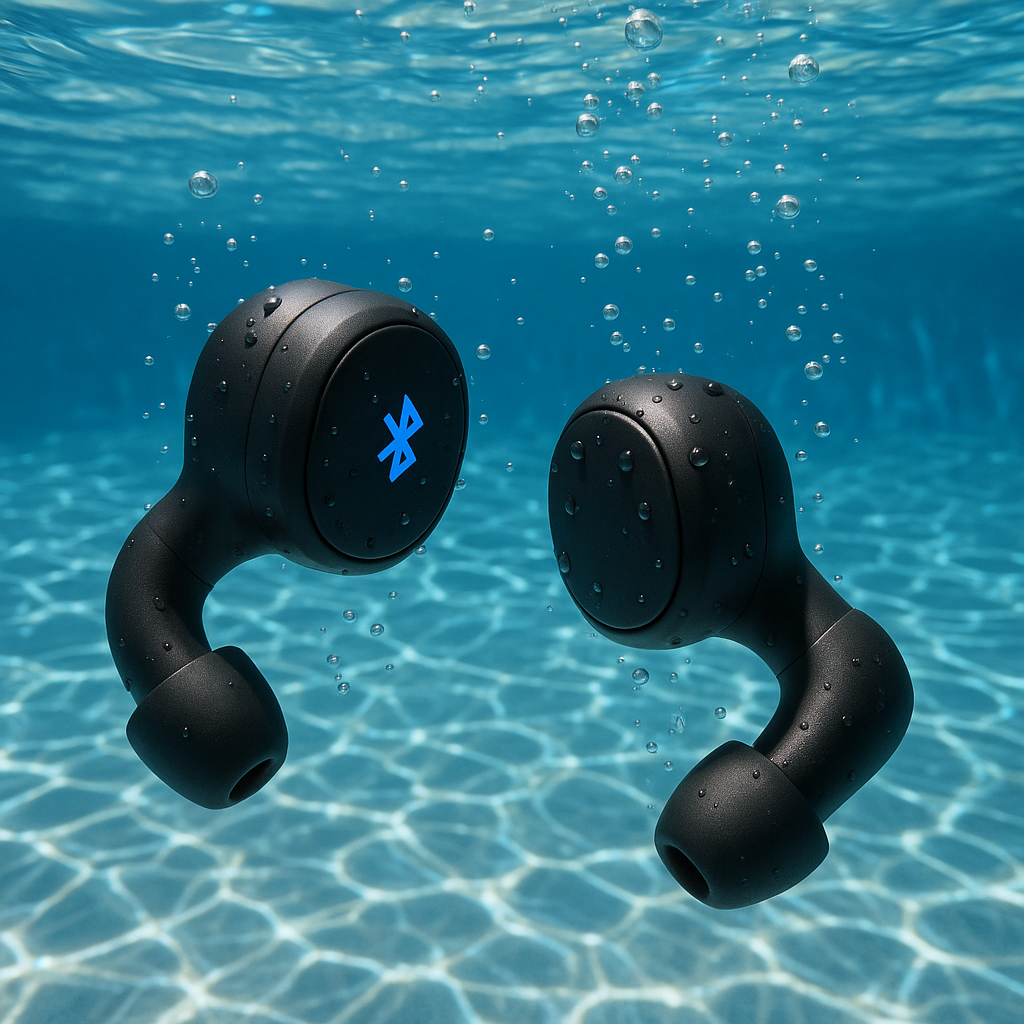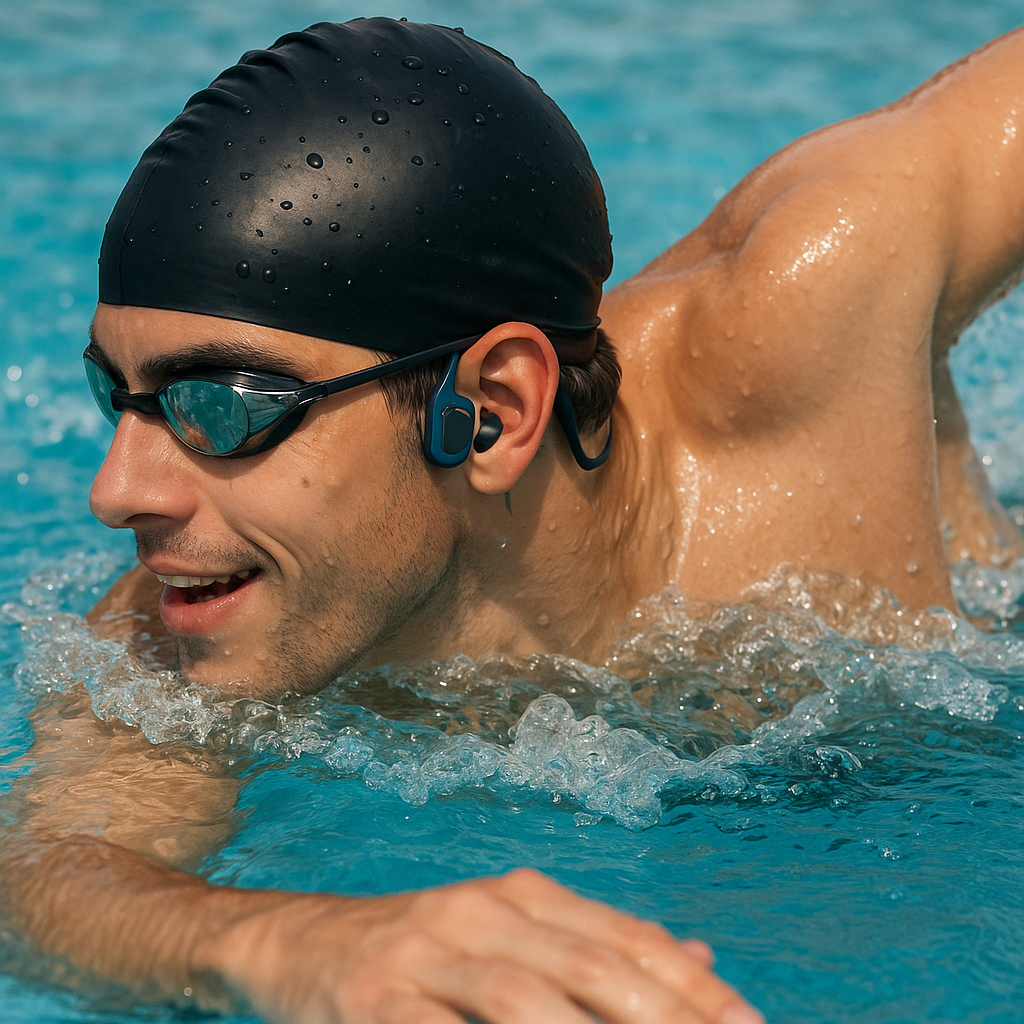Everyone knows waterproof bluetooth earbuds have revolutionized how we enjoy audio.
But what are waterproof bluetooth earbuds swimming and how do they actually work?
Here’s your definitive cheatsheet to decode the tech, the best models, and essential buying tips for swimming.
Some are designed with built-in memory to defeat Bluetooth limits underwater.
Some use bone conduction technology to deliver sound without blocking your ears.
Some integrate carefully crafted waterproof ratings, like IP68, to guarantee durability.
Some offer multi-use functionality, transitioning from pool to road seamlessly.
Let’s dive right in.
Why Traditional Headphones Fail Underwater
If you’ve tried using standard Bluetooth earbuds in the pool, you know how frustrating interruptions are.
Bluetooth signals struggle underwater due to water's density and conductivity which block radio waves.
The typical Bluetooth range on dry land is about 10 meters (33 feet), but this plummets as soon as the buds are submerged.
This is why swimming earbuds can't rely solely on wireless streaming from your phone.
Wireless streaming underwater is almost impossible because your phone loses connection and your headphones lose signal as soon as you dive in.
This creates constant drop-outs ruining your audio experience during a swim workout.
Hence, most waterproof earbuds swimming solutions come with built-in memory to store your music, podcasts, or training guides—no phone or data streaming needed.
This method guarantees continuous playback whether you're doing laps or open water swims.[1]
Key Technologies Behind Waterproof Bluetooth Earbuds for Swimming
Two main tech types dominate this niche: Bone conduction and in-ear waterproof earbuds with built-in players.
Bone conduction headphones work by transmitting sound vibrations through the bones of your skull directly to your inner ear. The ear canal stays open, letting you hear ambient sounds, which is safer during open water swims or triathlons.
These units sit outside your ear, often attached near the temple or cheekbones. They avoid water sealing issues and offer comfort for long wear.
While they don’t isolate noise perfectly underwater, using water-specific earplugs improves sound clarity.
Bone conduction is gaining popularity with models such as the AfterShokz Xtrainerz praised for combining pool and land use functionality.[1]
In-ear waterproof earbuds use highly specialized waterproofing (often IPX7 or IP68 ratings) and sealed internal music players.
They offer better sound immersion underwater but require perfect fit and seal to prevent water ingress and maintain audio quality.
Many come with multiple sizes of water-resistant earbuds to tweak comfort and minimize water entry.
These earbuds usually don’t provide Bluetooth streaming underwater but allow transfer of music via USB when dry before use.
Multi-format playback support (including MP3, FLAC, WMA) ensures flexibility.
Models from brands like FINIS and AGP Tech fit this category with extra features like small screens and FM radios.[2]
Top Features to Look For in Swimming Earbuds
- Waterproof Rating: At least IPX7 or ideally IP68 so they survive full submersion.
- Built-in Memory: 4 GB or more is ideal to hold hundreds of tracks without the need for phone proximity.
- Comfort & Fit: Multiple earbud sizes, secure fitting mechanisms (clips, straps), and low weight help earbuds stay put through turns and strokes.
- Battery Life: A minimum of 7-8 hours to last extended swim sessions or multiple workouts.
- Ease of Use: Simple buttons or touch controls, quick music upload (drag and drop), and clear navigation features.
- Sound Quality: High fidelity as possible underwater, but expect some muffling. Bone conduction offers safety with ambient sound awareness.
- Multi-Use Capability: Compatibility with dry land activities like running or cycling increases value.
- Extras: Noise-cancelling microphones for calls, fast charging, and additional accessories like ear plugs or caps.
A well-chosen waterproof bluetooth earbuds swimming set will combine these features to optimize your training and recreational pool experience.[1]
Best Waterproof Bluetooth Earbuds for Swimming in 2025
The market offers standout options that consistently earn praise from swimmers and triathletes. Here are top picks:
| Model | Type | Memory | Battery Life | Notable Features |
|---|---|---|---|---|
| AfterShokz Xtrainerz | Bone conduction | 4 GB | 8 hours | Open ear, swim mode, works on land, ambient awareness |
| Shokz OpenSwim Pro | Bone conduction | 32 GB | 28 hours | Bluetooth 5.4, noise cancellation mic, fast charge |
| FINIS Duo | In-ear with built-in player | Varies | 7-12 hours | Designed to clip to goggles, secure fit, water-specific buds |
| AGPTech Swimming Earbuds | In-ear with player & screen | 4 GB | Up to 12 hours | FM radio, shuffle, multi-format support, waterproof remote |
| Sony WF-SP800N | Water resistant, semi-waterproof | NA (streams) | Up to 9 hours | Ambient sound mode, excellent land use but not fully submersible |
We recommend bone conduction models for safety and comfort if you want to be alert while swimming outdoors or in open water.
For pool swimmers seeking immersive music, in-ear players with water-sealed designs are ideal as long as you ensure proper fit and care.
Remember: Bluetooth cannot stream underwater but can be used on land. The built-in memory feature is king when swimming.[2]
Quick tip: Choose earbuds with replaceable earbud tips designed specifically to keep out water and improve sound underwater.
Looking for a detailed look? Check out this

How to Use and Care for Your Waterproof Earbuds
Using swimming earbuds effectively means more than just putting them on and diving in.
1. Pre-swim Setup: Charge earbuds fully before swim, upload your favourite playlist or training session audio using the easiest drag-and-drop file system. Use multiple folders to organize your music by mood or workout type.
2. Fit and Seal: Experiment with different earbud sizes and water-resistant tips to ensure secure fit and minimal water entry. Proper fitting increases comfort and sound clarity.
3. Wearing Tips: Bone conduction models usually fit snugly around the back of the head and temples, staying put without ear canal intrusion. For in-ear types, add ear plugs if you want richer sound underwater and less water in your ear.
4. Post-Swim Care: Rinse earbuds with fresh water to remove pool chlorine or saltwater. Dry thoroughly before charging or storage to preserve longevity and functionality.
5. Storage: Use provided soft cases for bone conduction units or waterproof cases for in-ear models to protect during transport and storage.
6. Battery Tips: Avoid letting battery fully drain regularly. Use fast charging options if available to minimize downtime between sessions.
Following simple maintenance routines can extend the lifespan of your waterproof bluetooth earbuds swimming significantly, protecting your investment.
Expert Tips for Perfect Swimming Playback Experience
- Use Swimming Caps: Wearing a swim cap over your earbuds can help stabilize fit and reduce drag in the water.
- Waterproof Rating Awareness: Verify device IP rating especially if regularly swimming in open water or salt water where conditions are harsher.
- Ambient Awareness: Bone conduction earbuds allow you to stay aware of your environment while still enjoying music or audio training support.
- Choose Your Content Wisely: Sync motivating playlists or targeted swim training podcasts to boost focus and technique.
- Consistency Wins: Incorporate swimming earbuds into your regular workouts to break monotony and stay motivated during long sessions.
- Be Mindful of Surroundings: Always prioritise safety; do not let music isolate you from important environmental cues when swimming outdoors.
Common Myths and FAQs About Waterproof Bluetooth Earbuds for Swimming
Do waterproof earbuds really work underwater?
Yes, but Bluetooth streaming won't work underwater. Instead, earbuds use built-in memory, meaning you upload your tracks before swimming to listen seamlessly.
Are bone conduction earbuds better than in-ear models for swimming?
They serve different purposes. Bone conduction offers safety by leaving ears open and allowing ambient sounds, while in-ear models provide more immersive underwater sound but less environmental awareness.
How do I know if my earbuds are truly waterproof?
Check the IP rating. IPX7 or IP68 means they can withstand full immersion. However, always follow manufacturer guidelines to ensure durability.
Can I use swimming earbuds for other sports?
Many models double as multi-sport headphones, so you can use them for running or cycling. Bone conduction types are especially versatile for outdoor use.
Do swimming earbuds affect my swimming technique?
No, if fitted correctly, they stay securely in place and do not interfere with your stroke or breathing.
What's Your Next Step?
Tell us in the comments: How will you apply this to your swimming routine? For enriching your workouts, explore our guides on smart lifestyle upgrades that keep you energised and motivated.
Ready to enhance your swim sessions? Discover the best wireless earbuds under £50 to find quality sound on a budget at our comprehensive resource.
For comfortable training beyond the pool, mastering your comfort with an adjustable standing desk converter can boost your off-water productivity and wellbeing. Learn more about it here.

TL;DR: Waterproof Bluetooth earbuds swimming combine waterproof designs, built-in memory, and innovative technologies like bone conduction to deliver music underwater reliably. Streaming via Bluetooth underwater isn’t feasible, so these earbuds rely on internal audio libraries for seamless lap music.
Frequently Asked Questions
- Can I swim with regular Bluetooth earbuds?
- No. Bluetooth signals can't penetrate water effectively, causing frequent audio dropouts.
- What does IP68 mean on waterproof earbuds?
- IP68 means the device is dust-tight and can withstand prolonged submersion in water without damage.
- How long do waterproof swimming earbuds last on a charge?
- Most offer between 7 to 12 hours of playback, enough for multiple swim sessions.
- Do swimming earbuds affect ear health?
- Proper fit and cleaning prevent water retention and ear infections. Use recommended sizes and dry earbuds after use.
For detailed reviews and tips, check the comprehensive triathlete's guide and the YourSwimLog’s top picks, ensuring you choose the most durable, comfortable, and tech-savvy earbuds.
Finally, if you want to learn more about innovative tech that improves everyday experiences, check out this helpful guide on protective phone cases for seamless mobile use.






